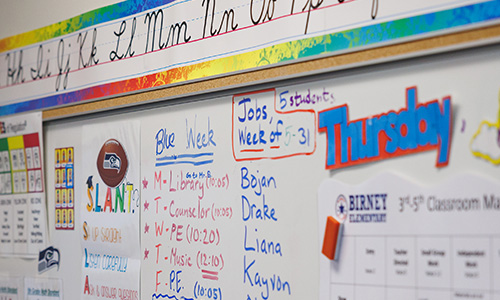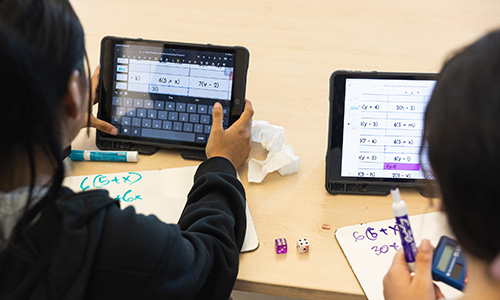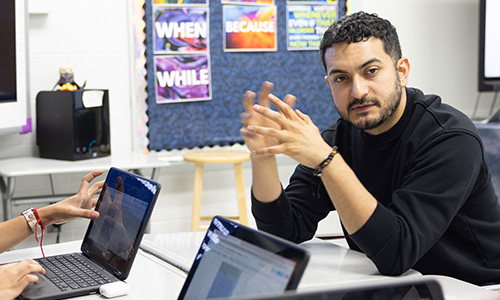
My stepdaughter is attending nursing school. During her initial hospital rotations, she wondered if she had made a mistake. She thought nursing would be more than distributing medications and giving injections. Then she was assigned to a pediatric ward. Yes, she was still distributing medications and giving injections, but her lens changed. Looking at nursing through the lens of pediatric care changed the story for her. Today, she aspires to work in a children’s hospital.
The lenses we use are important. We may not see the full story if we limit ourselves to one lens. In the science classroom, the crosscutting concepts are the lenses, or pathways, that students can take to make sense of something new, even when their understanding of disciplinary core ideas is not yet advanced enough to do so.
What are crosscutting concepts?
Crosscutting concepts are an “organizational framework for connecting knowledge from the various disciplines into a coherent and scientifically based view of the world.” They connect the practices of science and engineering with disciplinary core ideas when exploring and explaining novel phenomena.
The Next Generation Science Standards (NGSS) describe seven crosscutting concepts:
- Patterns
- Cause and effect
- Scale, proportion, and quantity
- Systems and system models
- Energy and matter
- Structure and function
- Stability and change
Using patterns
Although a fundamental part of sensemaking, educators agree that students need explicit instruction and opportunities to practice using crosscutting concepts. One way to easily bring the concepts into science lessons is to have students begin to explore phenomena using the lens of patterns. Ask students the simple question “What patterns do you observe?” and the follow-up question “What questions do you have?”
Here are three abbreviated scenarios that show possible outcomes of this approach.
Scenario 1: An introduction to an elementary Earth and space science lesson
Teacher: “Look up at the stars in the night sky. What patterns do you observe?”
Student A: “The stars are bright.”
Student B: “But some stars are not bright.”
Student C: “I don’t see the sun anymore. Isn’t the sun a star?”
Student B: “I see the pattern that some stars are bright, and some stars are dim.”
Teacher: “What questions do you have?”
Student B: “Why are some stars brighter than others?”
Student C: “Why can’t we see the sun at night with the other stars?”
Student A: “Are bright stars bigger than dim stars? The sun is a star. It is very big and very bright.”
Student B: “Or maybe bright stars, like the sun, are closer to us than dim stars.”
Scenario 2: An introduction to a high school life science lesson
Teacher: “Look at the model of a DNA molecule. What patterns do you observe?”
Student A: “Some atoms are always grouped together.”
Student B: “Yes, the groups repeat. They repeat through the center of the molecule.”
Student C: “I think there are four groups of atoms in the center of the molecule.”
Teacher: “Here is a model of a DNA molecule from a different organism. What patterns do you observe?”
Student C: “I see the same four groups of atoms.”
Student D: “I do, too, but they are in a different order.”
Teacher: “What questions do you have?”
Student E: “Do all DNA molecules have the same four groups of atoms?”
Student F: “Why are the sequences of the groups of atoms different in different organisms?”
Scenario 3: An introduction to an elementary life science and engineering lesson
Student A: “Deer ate all the vegetable plants in the school garden!”
Teacher: “Let’s go look at the garden.”
Teacher: “What patterns do you observe?”
Student B: “The deer are not eating all the plants, just some of them.”
Student C: “I think they like some plants more than others.”
Student D: “Me, too. They don’t eat the plants with the fuzzy leaves.”
Student E: “They don’t eat the onion plants.”
Teacher: “What questions do you have?”
Student A: “How can we design our school garden so the deer don’t eat the plants?”
Patterns don’t have to rely on visual experiences. Students may use other senses, accessible computer simulations, and other means to find patterns.
In the examples above, when uncovering patterns, students recognize relevant information and eliminate irrelevant information. They notice relationships and turn them into productive questions. Students’ questions and resulting investigative approaches can almost always be reframed using the language of the crosscutting concepts to highlight the lenses they will use. Here are examples for the three scenarios:
- Scenario 1: Students examine the relative scale of the sizes of the sun and stars and their distances from Earth.
- Scenario 2: Students examine the structure of DNA to determine how it functions to pass information from one generation to the next.
- Scenario 3: Students examine the causes behind what deer eat and don’t eat to reach the desired effect of a thriving school garden.
At the end of the exploration, students may construct evidence-based explanations. Again, the crosscutting concepts can be helpful. Teachers can direct students to look at their initial patterns for supporting evidence and to apply the crosscutting concept used to frame their question to guide their reasoning.
Always close with time for reflection
Reflection is another key component of using crosscutting concepts effectively in the classroom. Encourage students to reflect on the usefulness of the concepts:
- How did looking for patterns help you?
- How did you use those patterns?
- How might you use patterns when you encounter something new in the future?
Crosscutting concepts can become tools that students use repeatedly both inside and outside of the classroom. With the crosscutting concepts, all students can participate and learn to think constructively—like scientists, engineers, and everyday citizens.







